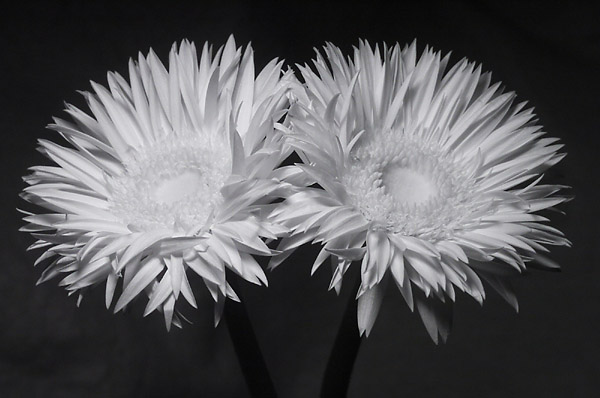 |
| South-African
Daisy (Gerbera
sp.) in b/w infrared Nikon D2H, UV-Nikkor 105 mm lens, Wratten 87C filter on lens, SB-14 flash with Wratten 87 filter, no ambient light |
| Nikon D2H Digital Camera Reviewed | |
| by Bjørn Rørslett | |
6. Infrared (IR) photography with D2H
One pleasant surprise with many of the digital cameras is their ability to record useful imagery outside the visible spectrum. Typically, the sensitivity to near-IR may be sufficiently high to allow IR photography not only in bright sunlight, but also under less well illuminated conditions. This is good news for any experimentally inclined end user, but bad news for the camera manufacturer.
The camera designers expressedly don't want IR to enter their cameras because IR will reduce perceived sharpness, make skies look washed out or experience colour shifts, produce blotched facial rendition, and visually increase the adverse impact of chromatic aberration (CA). Hence the anti-IR filter in front of the imaging chip inside the camera, typically seen as a greenish sheen when the CCD/CMOS chip is exposed to light. The anti-IR filter is combined with an anti-aliasing (AA) filter in a filter pack, which may or may not be removeable.
Each generation of Nikon D-series cameras has had its IR sensitivity decreased, or put the other way, the efficiency of the filter pack has increased. Nikon D2H is claimed to have a thinner AA filter so might be expected to have improved IR sensitivity as well. However, this assumption proved false. Thus, D2H has nearly 2 EV less IR sensitivity than the predecessor D1H, when I shot IR test scenes with each camera set up identically. With landscape motifs, D2H more than made up for the difference by its superb noise reduction, so for all practical purposes, D2H might still be the better IR camera of these in the end. This of course necessitates tripod use, but as far as I'm concerned, tripods are the normal means of mounting a camera anyway. No big deal.
Further test indicated however that D2H can be at least equally responsive to IR as D1H, for some special contingencies. Probably, this relates to the more gentle manner in which the internal IR filter rolls off its response toward longer wavelengths (see next paragraph). Incandescent lighting is just such a situation in which D2H may pick up more IR than you normally wish, and for which deployment of a hot-mirror filter may be a sensible cure.
Another striking feature with the IR rendition of D2H is its capability to acquire useful images even through the virtually black Wratten 87 or 87C filters. True, you can do the same with earlier D1-series models, or the D100 for that matter, but long exposure time and/or excessive noise would always be an issue with them shot this way. With the Wratten 89B (or equivalents, Hoya R-72 or B+W O-92), you get IR images from D2H rendered with a strong reddish or reddish-yellowish cast to them, and the red channel can easily blow out if you are not careful. Processing in software afterwards (Nikon Capture 4) can give a more appropriate colour balance if you wish. The virtually opaque, black 87 or 87C filters give images rendered mostly in shades of grey or light pink.
I haven't encountered long enough spells of nice weather to allow me to do field calibration of my D2H with the various IR-filters in terms of equivalent "ISO" ratings so far, but that will follow in due course. With the 87C filter anyway, IR sensitivity of D2H made shooting indoors flower portraits a breeze using my SB-14 flash equipped with a Wratten 87 filter on it. IR image tonality and level of detail were the best I've ever come across from any digital camera so far, DSLR or not.
 |
| South-African
Daisy (Gerbera
sp.) in b/w infrared Nikon D2H, UV-Nikkor 105 mm lens, Wratten 87C filter on lens, SB-14 flash with Wratten 87 filter, no ambient light |
The IR sensitivity of D2H should not pose any problem shooting IR with it in the field, at least for the typical target, dreamlike infrared landscapes. Just set up the shot, mount your IR filter, trip the shutter and let modern technology and digital noise reduction circuits do their designated jobs. I find the best IR images result from using Wratten 87 or 87C filters, because colour balancing images taken with an 89B filter sometimes can be quite tricky due to the fact that the red channel easily blows out.